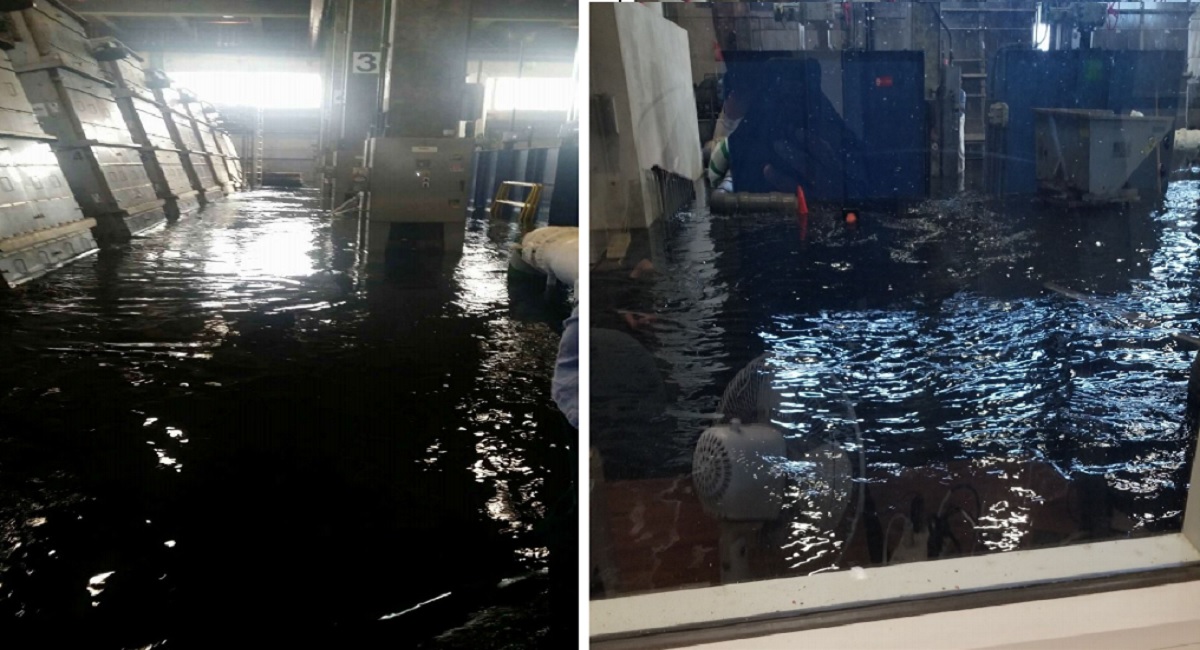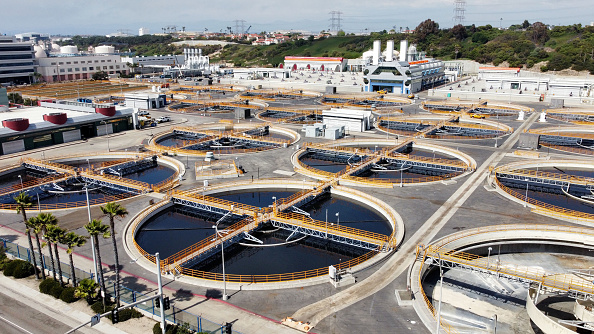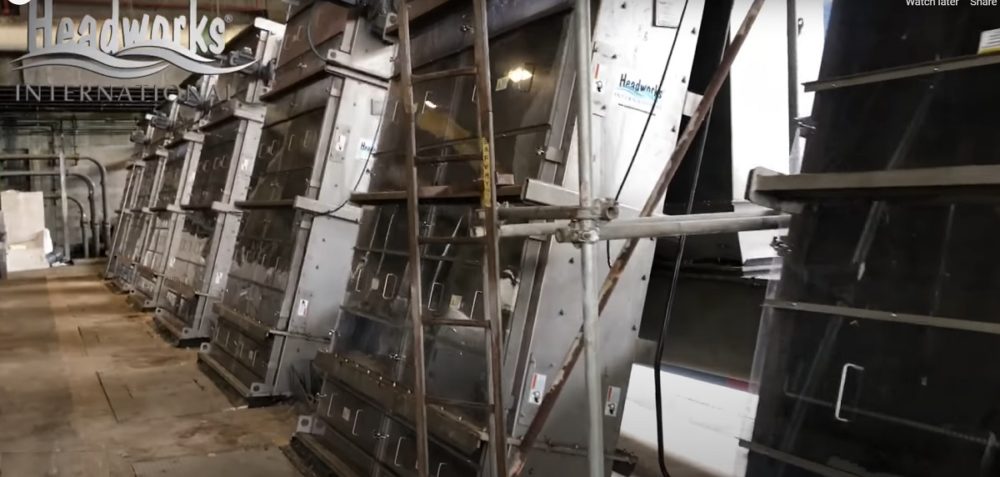
Flooding in the Hyperion Headworks building on July 11, 2021. (LA City San photo)
Keep up-to-date on the situation on LA City San’s Hyperion Incident webpage. According to the page treatment plant operations and odors are returning to normal levels.
Friday, 8/13 – LA City Sanitation & Environment releases a 30-day report to the AQMD and US EPA. The detailed report includes this heart-stopping moment by moment narrative of the wave of debris inundating Hyperion’s bar screens. LA City San’s investigation into the cause of the sudden flood of trash and debris continues.
The text below is from the report and we’ve edited for length, read the original report.
Around 1:00 PM on July 11, 2021, the Headwork Facility began experiencing problems. Headworks water level upstream of the barscreen was rising. The unusual rise in the water level may be an indication of plugging of the barscreens as debris accumulates.
Around 1:45 PM, the day shift field operator (WTO I) assigned to the Headworks Facility made his last rounds of the equipment before the end of shift at 2:00 PM. Four barscreens (#2, #4, #6 and #8 with 0.375-inch spacing) were in service and four barscreens (#3, #5, #7 and #9) with 0.75-inch spacing were on stand-by at that time.
Based on dayshift WTO I last rounds at 1:45 PM and historical trends, it appears that the first barsceen tripped and was offline at 2:00 PM. Swing shift started at 2:00 PM with the same field operator from the day shift covering the swing shift.
Historical alarm data from DCS shows an urgent priority alarm was triggered for Barscreen Influent Channel High Level Alarm (HHWKLAH216) at 2:10:31 PM and low priority alarm for Influent Channel Level (HHWKL1001) at 36.51 feet.
While monitoring the screening trough around 2:45 PM, the WTO I noticed there was an intermittent suction problem coming from Chopper Pump #2, which conveys screen debris for compaction. (At 3:13 PM) WTO I called the Swing Shift WTO II to submit a Work Request for maintenance to work on the chopper pumps as there no longer a reliable standby pump.
Chopper Pump #1 was placed online. After Chopper Pump #1 was placed online, the WTO I was monitoring the screening trough (Hyperion uses a sluiced screening system) and noticed a level decrease in the trough. It was at this time that it was realized barscreen #2 was offline. As the barscreens have a 30 second delay before the rakes move at times, WTO I waited approximately 1-2 minutes and then confirmed it was offline. WTO I tried resetting the barscreen, but was unsuccessful. It was at this time that WTO I realized all of the barscreens were offline.
The WTO II was then called on the radio for immediate assistance. During this time, there was no flooding, but noticed there was a water mist coming out of the floor plates and drains.
Around 3:15 PM – 3:30 PM, standby barscreens were being placed online.
By 3:30 PM to 4:00 PM, the Headworks Facility was overwhelmed, and untreated wastewater began overflowing out of the Headworks building and into the street within Hyperion and flooding the plant.
Once the WTO II arrived at the Headworks, all efforts were being utilized to unclog offline barscreens and place them online. At one point, the level of the water on the ground seemed to have been dropping and the operators had six barscreens online, but then all barscreens tripped offline at around 4:30 PM. By this time, all eight available barscreens had tripped on motor overload. Seven operators came for assistance and the Shift Superintendent.
After all efforts were exhausted in getting the barscreens online, the operators attempted to open the headworks emergency bypass gate around 4:30 PM to allow incoming untreated wastewater to bypass the plugged barscreens. However, they had difficulty removing the bulkhead upstream of the bypass sluice gate possibly due to accumulation of trash and other debris. Operators were walking around using push brooms and squeegees to make sure they were not going to fall in any open holes.
At around 5:00 PM the level of the overflowing untreated wastewater in the Headworks was knee high. The headworks area was evacuated at around 5:30 PM as a safety measure.
Untreated wastewater from the street within Hyperion flowed into the plant’s storm drain system (CSD No. 1 and CSD No. 2) and into the pipe galleries and pump rooms below ground. Around 7:00 PM on July 11, 2021, excess untreated wastewater from the storm drain system began to overflow to 1-Mile Outfall.
On Monday, July 12, around 1:00 AM to 2:00 AM, cover plates by the aerated grit basins, in front of Primary tanks and Effluent Pumping Plant (EPP) were opened to minimize flooding and allow untreated wastewater to flow to the liquid process for treatment.
Approximately around 4:30 AM, the bulkhead was finally removed allowing incoming untreated wastewater to bypass the barscreens and flow into downstream treatment processes.
At 8:40 AM, on July 12, 2021, with two barscreens back in service and the emergency bypass channel open, flow to 1-Mile Outfall finally stopped. Initial calculation determined that up to 16.874 MG of untreated wastewater overflowed into the ocean from CSD Nos. 1 and 2, approximately 0.134 MG and 16.74 MG, respectively; and 0.08 MG to the 5-Mile Outfall.
On July 12, 2021 at 3:00 PM, four barscreens were back in service. However, the Headworks emergency bypass channel was still open allowing trash and debris to enter the treatment process.
The emergency bypass channel was closed on July 15, 2021.

Thursday, 8/5 – Photos above are from an LA Sanitation & Environment presentation to a City of Los Angeles City Council committee
Friday, 7/23 – Los Angeles County has released a third-party report that looked at what happened during the incident when Hyperion was inundated with debris. Hyperion is owned and operated by the City of Los Angeles.
Highlights from the report include:
The preliminary report compiled by Citygate Associations consulting firm concludes:
The handling of this release and the necessary public notification were failures. The fact that the Plant staff saved their Plant, with limited ocean damage and no water samples the day of or after detected contamination is due to current Plant design and what the Plant staff did under extraordinary circumstances and pressure. Next time, however, it may not be enough.

A 2019 photo of Hyperion’s bar screens and headworks building, photo by Headworks Inc (View the video on YouTube).
Wednesday, 7/21 – the City of Los Angeles, Bureau of Sanitation and Environment has released the following statement.
The hard working and dedicated frontline staff of LA Sanitation and Environment consider themselves guardians of the Santa Monica Bay and Hyperion Water Reclamation Plant as their home. Just as they have done during rain or shine, 24 hours per day, 365 days per year, and even through a major pandemic, they put up a valiant struggle to save Hyperion and the Santa Monica Bay during the emergency overflow discharge that began on July 11th. Their heroic efforts averted a much larger catastrophe, and limited the discharge of untreated wastewater to 17 million gallons, which is a small fraction of the 260 million gallons per day that could have polluted Santa Monica Bay for days on end.
On the afternoon of Sunday July 11, 2021, the Hyperion Water Reclamation Plant became inundated with overwhelming quantities of debris, causing backup of the headworks facilities. The plant’s relief system was triggered and wastewater overflows were controlled through use of the plant’s one-mile outfall system at 7 pm which resulted in the discharge of untreated wastewater into Santa Monica Bay. Normally the discharge of secondary-treated effluent is through the five-mile outfall. During the over eight hours of discharge through the one-mile outfall, approximately 17 million gallons of wastewater (representing six percent of an average daily load) was discharged as a controlled emergency measure through its one-mile outfall relief system to prevent the plant from going completely offline and discharging much more untreated wastewater. The overflow of wastewater was through the one-mile outfall rather than the five-mile outfall because the plant’s internal storm drains are connected to the one-mile outfall to ensure stormwater flows do not overwhelm wastewater treatment processes.
Per established protocols, the State of California Office of Emergency Services (Cal OES) and the National Response Center were notified respectively at 8:10 pm and at 8:18 pm on July 11th. State Law requires that an unauthorized discharge of sewage [as defined in 23 California Code of Regulations (CCR) 2250 (b)] into or onto state waters must be reported to Cal OES. Cal OES will then immediately notify the appropriate Regional Water Quality Control Board, the local public health department, and the local office of environmental health. These offices are responsible for determining appropriate public and environmental safety measures.
Plant staff was onsite all night and resolved the issue early Monday morning. Overflow of wastewater from the plant headworks flowed through roadways within the plant, inundated multiple buildings on site, flooded underground pipe galleries, submerged equipment and caused significant damage. On Monday July 12th during low influent into the plant at around 4:30 am, a previously submerged metal plate was lifted to provide an opening for plant flows to bypass the bar screen filters at the plant headworks and flow downstream into treatment processes. The opening of the bypass gate stopped flooding within the plant and overflow of wastewater into the one-mile outfall.
Numerous improvements over the years, in partnership with several environmental groups, helped to mitigate the flow into the ocean, including reconfiguration of in-plant storm basins to pump sewage back into the plant in cases of emergency; installation of screens on all catch basins to prevent untreated debris from entering the storm drains and discharging out to the ocean; and installation of a Headworks Bypass to allow diversion of flow away from the bar screen filters and into a bypass channel directed back to the treatment process.
Water quality sampling and testing of shoreline (beach) samples were conducted, and our monitoring vessel traveled to both outfalls to make observations and take samples for analyses following regulatory permit protocols. Sampling locations were centered along the shoreline at the 1-Mile Outfall pipe. From there staff went north and south at distances of 100 meters, 0.5 mile, 1 mile, 3 miles, 5 miles, and 7 miles; these sampling sites extended from the Santa Monica Pier south to Avenue A in Redondo Beach. Samples were collected for total coliforms, E. coli, and Enterococcus. Five days of testing revealed normal bacteria levels, well below the state water quality limits for each type of bacteria.
The nearly catastrophic flooding of the Hyperion Water Reclamation Plant on July 11, 2021 resulted in significant areas of the plant being submerged under water and major damage to equipment and processes that treat and clean wastewater. Despite these impacts, Hyperion continues to treat wastewater through its secondary treatment process before discharge through its standard five-mile outfall.
City of Los Angeles forces and contractors are working around the clock to pump wastewater out of inundated facilities, sanitize facilities and equipment, and mitigate hazardous conditions inside the facilities caused by the flooding. It is expected to take a month or more to repair damaged facilities and equipment in order to restore full functionality to Hyperion. Our commitment is to complete the repairs as soon as possible.
Hyperion generates digester gas which is a byproduct of wastewater that the plant receives each day. Since April 2017, digester gas, a renewable energy, is used to generate over 20 megawatts (MW) of power each day from the state-of-the-art Hyperion Bioenergy Facility. The 20 MW of power which is used to meet the plant’s power demand is enough to power about 30,000 homes and is the equivalent of removing about 95,000 tons/year of greenhouse gases from the environment, and about 20,000-cars equivalent.
The flooding of Hyperion on July 11, 2021 significantly reduced the amount of digester gas available to generate power, which resulted in a temporary shutdown of the Hyperion Bioenergy Facility. Because the production of digester gas is low and insufficient to run the Hyperion Bioenergy Facility, the unused gas is combusted by utilizing plant equipment permitted by AQMD, which may intermittently produce visible smoke or flames.
We ask for your patience during the reconstruction period as you may experience intermittent odors, noise, or see smoke or flames emitting from plant equipment permitted by AQMD to combust unutilized digester gas. Hyperion is taking all measures to minimize and mitigate impacts (odors, noise, etc.) to the community during the cleanup and repairs to fully restore functionality of the plant.
We sincerely apologize for any inconvenience experienced as a result of the flooding incident on July 11, 2021. Please contact LA Sanitation & Environment’s 24-hour Customer Care Center at 1-800-773-2489 to express specific concerns or to file a complaint. If you feel that you have lost money or property as a result of any action or inaction by the City of Los Angeles, you can file a claim by clicking here.
– end of statement –
Here’s what we know day-by-day according to information released by LA City Sanitation & Environment and other groups:
News coverage: